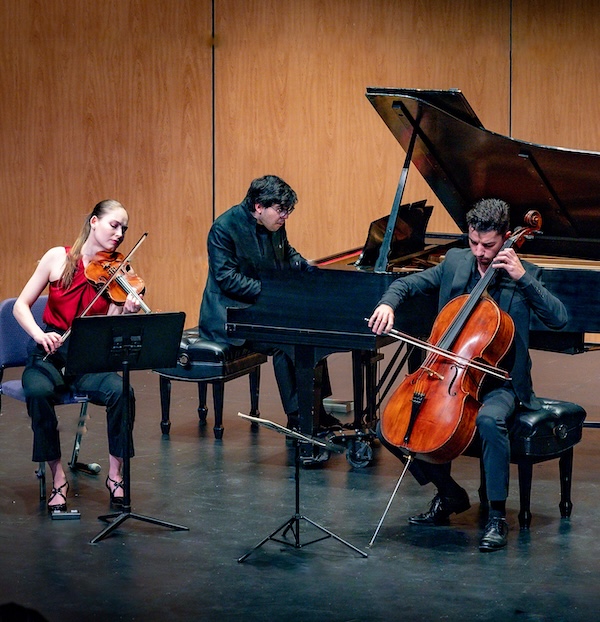Geneva Lewis and friends shine with a soft glow for Candlelight Concert Society

Violinist Geneva Lewis, cellist Gabriel Martins and pianist Evren Ozel performed Beethoven’s “Archduke” Trio Saturday night in Columbia for the Candlelight Concert Society. Photo: Bernie Carrieri
Musicians, like many people, often form their closest friendships in college. New Zealand-born violinist Geneva Lewis’s collaborative bond with pianist Evren Ozel and cellist Gabriel Martins was audible in their performance Saturday evening at a Candlelight Concert Society concert at the Horowitz Center in Columbia. All three were once students at New England Conservatory of Music, who have gone on to promising careers.
Lewis and Ozel, who both won Avery Fisher Career Grants in recent years, partnered for three unusual pieces in the first half. Béla Bartók first composed his Romanian Folk Dances as a suite of six short pieces for piano in 1915, later orchestrating them for a small ensemble, then arranging for violin and piano. In his ethnomusicological fieldwork, Bartók collected all these melodies in a region of Hungary that later became part of Romania, where he himself was born.
The first two movements, the “Stick Dance” and the “Sash Dance,” showcased Lewis’s impeccable intonation and elegant tone. Her outstanding technique stood out most in the whistle-tone harmonics of the third movement, a flawless imitation of the shepherd’s flute on which Bartók heard some of these tunes played. Startling accuracy of attack came across in the faster dances that concluded this brief piece, ably coordinated with Ozel.
More folk music influence abounded in Fazil Say’s Violin Sonata No. 1, with the Turkish flavor not distant from the Romanian pieces, since Bartók’s region of Europe was once under Ottoman rule. The Turkish pianist and composer said of this youthful 1997 work that “listening to it is like taking a short trip to Anatolia.” Exotic scales, extended piano techniques, and jazz-inspired harmony all contribute unusual colors.
Lewis lent her sweet tone to the sentimental tune of the melancholy first movement, delicate on the high end of the E string. The grotesque second movement, which Say said evoked “the jazz that is played in an Ottoman palace,” had a fun irreverence about it. Ozel placed a book on the piano’s bass strings in this music, which produced a barely audible buzzing sound called for in the score, something like the twang of a plucked double bass.
The “Perpetuum mobile” movement, aping an energetic dance called the horon, proceeded with explosive urgency, eliciting impressive virtuosity from both musicians. The fourth movement, a relaxed setting of the folk song “Odam Kireçtir,” sighed with delicious ennui, with Lewis’s line in harmonics heard as if through a veil of hookah smoke. In the second half of this movement, Ozel damped the piano strings with his left hand to create a signature Say sound, like the fervent plucked notes of a Turkish oud. The fifth movement, a reprise of the first, felt more steeped in quiet nostalgia.
Stravinsky’s Divertimento from the ballet Le Baiser de la fée, in the arrangement by Samuel Dushkin for violin and piano, rounded out this 20th-century opening set. Like the other two works, it looks backwards, in this case to the music of Tchaikovsky. Lewis dispatched all of Dushkin’s technical challenges with disarming ease: perfectly tuned double-stops, rich tone in the instrument’s low range, and a folksy rhythmic bounce in the “Dances suisses” section.
Lewis is foremost a player of subtle finesse, even in sections where a brawnier approach might have satisfied more. To his credit, Ozel mastered the multiple heavy textures of the piano part, always with an ear toward not overwhelming the more demure sound of his musical partner. No surprise that the tender music of the concluding movement, the “Pas de deux” for the lovers, proved the highlight.
After intermission cellist Gabriel Martins joined his colleagues for Beethoven’s Piano Trio No. 7, the celebrated “Archduke.” It quickly became apparent that Martins shared the same mindset about the softer side of the dynamic range, as the two string players seemed to vie with each other to make the least obtrusive sounds. By default, this put Ozel in the foreground at the piano, and he led memorably from the opening of the first movement, choosing the right, slightly hesitating pace. The trio made its most forthright sounds in the fuller development section.
All three musicians agreed immediately on a similarly genial tempo for the Scherzo, exploiting the chromatic weirdness of the Trio section for maximum effect. In the slow movement, the soft playing of both violin and cello became almost evanescent at times. Ozel again claimed the spotlight in the spirited Finale, his right hand defined and clear in filigree passages.
Geneva Lewis and Gabriel Martins play a different program, with music by Mozart, Ravel, and Handel, 3 p.m. today at the Peale Museum. candlelightconcerts.org

